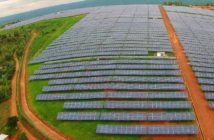 GE is introducing what it is calling a major energy efficiency breakthrough for desalination plants. Its new IPER system promises to reduce the energy demands of desalination pumping by at least 10 percent.
GE is introducing what it is calling a major energy efficiency breakthrough for desalination plants. Its new IPER system promises to reduce the energy demands of desalination pumping by at least 10 percent.
Its new Integrated Pump and Energy Recovery (IPER) system is “a major engineering breakthrough that overcomes a significant technical obstacle for larger desalination facilities by reducing the energy demands associated with pumping water by at least 10 percent.”
The announcement of its IPER system was recently made during the 2012 Singapore International Water Week in Singapore.
“Considerable progress has been made in membrane and energy recovery device improvements, dramatically lowering the energy requirement of seawater reverse osmosis (SWRO) desalination plants over the past 10 years. Until now, energy efficient positive displacement (PD) pumps have been able to achieve significant energy savings in smaller desalination operations. Meanwhile, modest improvements to large, conventional centrifugal pumps have been able to deliver only incremental energy savings. However, with IPER, GE is offering a new positive displacement pump system that will significantly lower energy requirements for large desalination plants.”
A pilot version of the IPER system has been installed at the ‘Water and Sewerage Corporation, a desalination facility in Tarpum Bay, Bahamas’, in order to demonstrate the efficiency and reliability of the technology.
“IPER is designed to offer customers reliable uptime for their packaged desalination water treatment plants while reducing their energy costs in a significant and quantifiable way,” said Heiner Markhoff, president and CEO—water and process technologies for GE Power & Water. “IPER represents a major economic and technical break-through that is poised to help desalination operators play an even greater role in addressing the world’s mounting water scarcity problems.”
75% of the Earth’s surface is covered with water, but only about 0.8% of it is available for domestic use. About 80% of all diseases and sicknesses are related to water. Water scarcity already threatens one out of five people, and it’s project that number will actually increase to three in five within 20 years.
The IPER system is intended to help drive continued innovation in the global water treatment and reuse, and hopefully enable the availability of cleaner water where it is in scarce supply. Certainly a worthy cause.
Here are some more details on how this technology works and improves upon conventional desalination plants:
“Lower-capacity desalination plants have often utilized PD pumps because of their high efficiency and availability. These small but efficient pumps are based on the use of a fixed geometry and either rotating axial pistons or crank-driven pistons to pressurize water in the chambers. As the size and pumping capacity of these chambers increase, these smaller PD pumps face mechanical challenges. As a result, previous larger PD pumps have either featured a larger crankshaft or high crankshaft speeds to overcome these mechanical challenges. But due to the larger size and operating speeds, these solutions have led to significant vibration and maintenance issues.”
“IPER solves these problems by eliminating the crankshaft and replacing it with a unique hydraulic drive system for both functions. This hydraulic drive powers three double acting pistons in the water displacement unit and does this at very slow cycle speeds as compared to traditional PD pumps.”
“These innovations allow larger SWRO systems that today use less efficient centrifugal pumps to incorporate IPER positive displacement pumps in the future. Since positive displacement pumps are typically used on systems with a capacity of less than 1,000 m3/day, this offers opportunities for any plant of 1,000 m3/day or larger to achieve substantial energy savings. IPER is the latest solution to join GE’s industry leading desalination platform, which also features innovative membrane technologies that transform seawater and brackish water into fresh water for drinking, irrigation and industrial applications. GE’s versatile, energy efficient SWRO and electrodialysis reversal technologies produce water reliably and affordably while accommodating a range of sizes, across continents, for almost any salt or brackish water source.”
“Since RO facilities typically require 53 percent less energy than thermal desalination facilities, IPER’s introduction underscores how GE is committed to helping desalination operators reduce their energy costs during both the filtration and pumping stages.”
Whatever you think of giant multinational corporations, GE certainly has some decent bragging rights in this arena.
Another key way to increase water availability, of course, is to switch to renewable energy technologies that use much, much less water. Better desalination and water purification technologies combined with a renewable energy transition will hopefully turn the water scarcity trend in the other direction and help people all over the world.
Source: GE
Source: Clean Technica (http://s.tt/1hp34)
Genesis Morocco : http://genesismorocco.blogspot.com
from Genesis Morocco http://genesismorocco.blogspot.com/







